Hydrogen-rich bath with nano-sized bubbles improves antioxidant capacity based on oxygen radical absorbing and inflammation levels in human serum
Yoshiharu Tanaka, Li Xiao, Nobuhiko Miwa
1 Division of Biology, Faculty of Liberal Arts and Sciences, and Division of Quantum Radiation, Faculty of Technology, Osaka Prefecture University, Osaka, Japan
2 Department of Pharmacology, School of Life Dentistry at Tokyo, The Nippon Dental University, Tokyo, Japan
3 Incorporated Association Institute for Hydrogen Medicine, Hyogo, Japan
4 Faculty of Life Sciences, Prefectural University of Hiroshima, Hiroshima, Japan
Abstract This study compared the effects of hydrogen-water (HW) bath on the oxygen radical absorption-based antioxidant capacity and the inflammatory indicator, C-reactive protein (CRP), in serum between healthy volunteers and inflammatory/collagen disease-patients.The HW bath apparatus supplied nano-bubbles with a diameter of 110 ± 10 nm and 338–682 μg/L of dissolved hydrogen after 120 minutes electrolysis, and nano-bubbles increased to 9.91 × 107/mL along with the increase of correlative dissolved hydrogen.Ten-minute HW bath increased the oxygen radical absorption-based antioxidant capacity to 110.9 ± 9.2% at post-bathing 120 minutes, although unaltered with 10-minute normal water bath at 40°C in healthy subjects.The CRP level was repressed to 70.2 ± 12.1% at 120 minutes after HW bath, although rather increased for normal water bath.In the patients with connective tissue diseases, the CRP level was repressed to 3–24% upon 9 days to 4 months of HW bathing.In another six patients with diverse autoimmune-related diseases, upon daily HW bathing as long as 2–25 months, the pre-bathing CRP level of 5.31 mg/dL decreased to 0.24 mg/dL being within the standard-range, with relief of visible inflammatory symptoms for some cases.Thus, the HW bath with high-density nano-bubbles has beneficial effects on serum antioxidant capacity, inflammation, and the skin appearance.The study was approved by the Committee of Ethics, Japanese Center of Anti-Aging Medical Sciences (Authorization No.H-15-03-2, on January 15, 2019), which was a non-profitable organization officially authenticated by the Hiroshima Prefecture Government of Japan.
Key words:anti-inflammatory effect; antioxidant capacity; C-reactive protein; electrolysis; human serum; human skin; hydrogen-rich water; nano-bubble
INTRODUcTION
Reactive oxygen species (ROS)-induced oxidative stress plays a major role in chronic inflammatory diseases.1As it tends to exhaust the endogenous antioxidants, cause damage to various cellular structures, and consequently accelerate cellular senescence,2antioxidant supplementation strategies have been used as effective solutions for treating oxidative stress-related diseases and delaying aging.3,4
Mean serum total antioxidant capacity (TAC) indicates the ability of an organism to reduce oxidative stress.Moreover, a decreased TAC is usually associated with various diseases.In people with multiple sclerosis,5acute coronary syndrome,6or metabolic syndrome,7the TAC is significantly lower than that of healthy people.A meta-analysis has also shown that patients with Alzheimer’s disease have significantly lower plasma levels of antioxidants8compared with healthy older adults.Therefore, an increase in TAC could improve health and prevent diseases.
Recent studies have considered hydrogen molecule (H2) as a novel medical gas with antioxidant properties.9-12Numerous experimental and clinical studies have demonstrated that hydrogen can protect cells, tissues, and organs from oxidative stress-induced injuries by scavenging ROS.13,14Hydrogenrich water also can increase the antioxidant capacity in cultured human gingival fibroblasts.15Hydrogen-enriched electrolyzed water is guaranteed for safety in human body16and hydrogen also has beneficial effects on the human body, including preventive effects on the development of metabolic syndrome,10,17improvement of lipid metabolism,18antiinflammatory effects,19,20reductive relieving effects on the side effects of oxidative cancer treatment,21and improvement of autonomic nerve functions.22
Several methods of administering hydrogen exist, such as inhaling hydrogen gas and drinking hydrogen-water (HW).The living cells also constantly produce ROS.However, excess amounts of ROS produced by inflammation, stress, and many diseases (e.g., tumorigenesis) are diminished by the hydrogen molecules as hydrogen-rich water has been known for its oxidative stress-alleviating properties.23Therefore, the symptoms would be reduced.In a newly developed instrument with a grand electrode additive to normal one pair of cathode/anode electrodes, designated as Lita Life Ver.2, which produces hydrogen-rich water by electrolysis, the microscopical non-bumpy gilding with platinum on the electrode surface or the released platinum ions, being hydrated to form colloidal nano-bubbles, adsorbs hydrogen molecules and stabilizes for a long time.Therefore, even after 10-minute boiling and the subsequent natural cooling, the hydrogen will still be abundantly dissolved, making hydrogen-rich water.24
In our previous study, tap water is considered suitable in making high-quality hydrogen-rich water (high dissolved hydrogen [DH]) and low oxidation-reduction potential.23In the present study, we investigated the physical properties of nanobubble hydrogen-rich water bath to find the best condition for maintaining a high concentration of hydrogen in the warm water and the effects of nano-bubble hydrogen-rich water bath on the oxygen radical absorption capacity (ORAC)-based antioxidant capacity and C-reactive protein (CRP) level of the serum as well as inflammatory symptoms among the subjects for both short-, medium- and long-term periods.
sUBJEcTs AND METHODs
Preparation of HW bath
A HW generator Lita Life Ver.2 (Lita Heart International Co., Ltd., Osaka, Japan) which produces hydrogen bubbles via electrolysis (Figure 1A) was used according to the manufacture’s protocol.The apparatus is composed of three blades of electrodes, with an electric power supply as the main body (Figure 1B).The nano-sized bubbles which contain gaseous hydrogen were produced via the electrolysis of warm (40°C) water of 200 L poured into a bathtub.The bath water was electrolyzed for 60 minutes, immediately followed by 10-minute bathing.For the measurement of the heat-durable properties of the HW, the water was boiled for 2 minutes after electrolysis and then naturally cooled down for 3 hours until it reached room temperature.
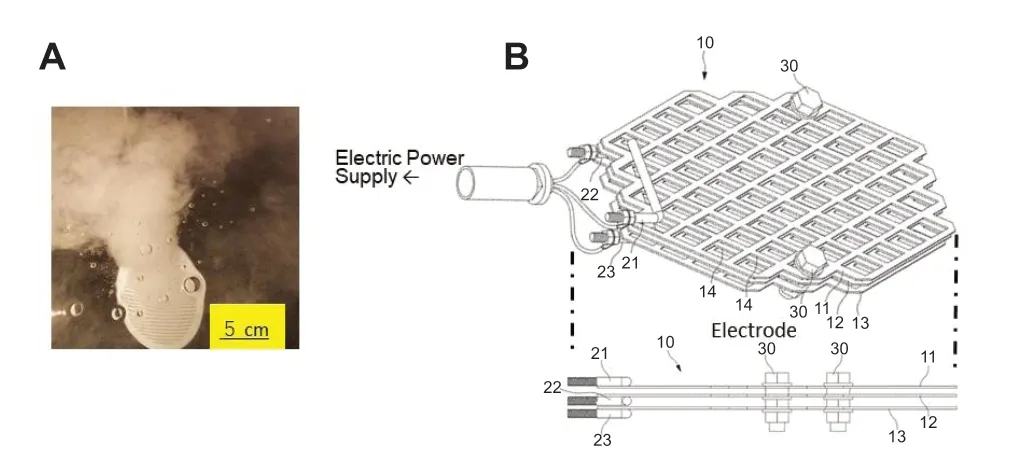
Figure 1:Electrode of a hydrogen-water-producing apparatus, a photograph of its operating state and structural drawing of the electrode.
The water samples obtained at different time points were analyzed using a Nano Sight LM10V-HS (Malvern Instruments Ltd., Malvern Worcestershire, UK) system.Polystyrene latex particles (AGS130-1, 0.095 μm (5 mL); Agar Scientific Ltd., Stansted, UK) in the water were used as the standard particles.Size, frequency-distribution, and number of nano-bubbles were analyzed using a nanoparticle tracking analysis software (Malvern Instruments Ltd.).Each sample was tested five times.
The DH concentration in the water was detected with a polarographic diaphragm type device with DH selective electrode (DH meter, KM2100DH, Kyoei Electronics Research Institute, Saitama, Japan) according to our previous research.15The normal warm tap water (40°C, 200 L) without undergoing electrolysis was used for the control group.Dissolved oxygen (DO) concentration was detected with a polarographic DO meter, DO-5519E (FUSO Co.Ltd., Tokyo, Japan).
Preparation of serum from healthy and disease volunteers
The recruitment of healthy and disease volunteers was executed by the Internet of the Incorporated Association Institute for Hydrogen Medicine on September–November, 2015, in Osaka Prefecture.This study was accorded with the Ethical guidelines for clinical research of Ministry of Health, Labour and Welfare, Japan.Figure 2 shows the flow chart of analysis on heathy and disease volunteers at this work.This work is composed of three case-studies as follows.
Measurement of properties of HW made by an electrolysis apparatus
The formation of hydrogen bubbles was video-recorded after 60 minutes electrolysis using a sCMOS microscope/video camera (Hamamatsu Photonics, Hamamatsu, Japan) with a magnification of approximately 200,000 and a speed of 25 frames per second.
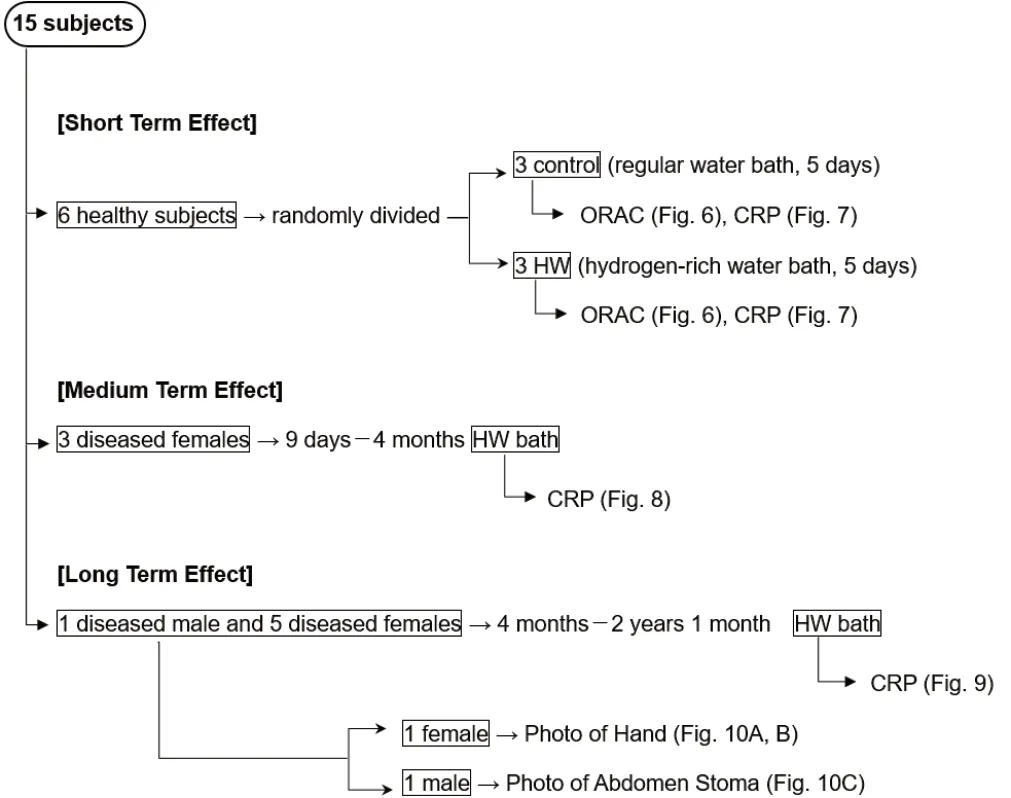
Figure 1:Flow chart of analysis on heathy and disease volunteers.
Six healthy volunteers were randomly divided into two groups according to a level of the case report:the control group (n= 3, regular tap water bath, 40°C, 10-minute bathing) and the HW group (n= 3, hydrogen-rich water bath, 40°C, 10-minute bathing).Each group contained two males and one female, aged 40–70 years old.All six subjects did not have any chronic diseases nor did they take specified antioxidant nourishment and exercise excessively, for 5 days before and during the examination.Six subjects examined were previously chosen by being confirmed to be within the normal range of body mass index (20.0–24.9 kg/m2) and waistline (85 cm for man and 90 cm for woman in average) described in the Website of the Ministry of Health, Labour and Welfare, Japan.25The blood from each volunteer was obtained from the fingertip by a disposable puncture needle immediately in the following time periods:before bathing, right after finish of bathing (0 minute), and 10, 30, 60, and 120 minutes after bathing.The blood was centrifuged at 3000 r/min, 10 minutes at 4°C, and then the supernatant was used as serum.The serum samples were then diluted, followed by ORAC and CRP enzyme-linked immunosorbent assay assays.
In order to examine the medium-term effect of hydrogenrich water bath, three females with connective tissue disease, one (60 years old) with collagen disease and one (60 years old) diagnosed according to the 2012 Provisional Classification Criteria for Polymyalgia Rheumatica26were included in this study.In order to examine the medium-term effect of hydrogen-rich water bath, they were asked to take a 10-minute HW bath every day for 9 days.Diverse durations of 9 days to 4 months were determined by respecting their desire of the HW bath-using periods with reference to improved CRP values.Their sera samples were then collected before and after the examination period as described above.
In examining the long-term effects of the hydrogen-rich water bath, six subjects were included:(1) 68-year-old male suffering from acute aortic dissection and enema; (2) 42-yearold female suffering from bladder cancer and pyelonephritis; (3) 60-year-old female suffering from collagen disease and dermatomyositis; (4) 60-year-old female suffering from rheumatic polymyalgia; (5) 73-year-old female suffering from rheumatoid arthritis and left shoulder clavicle fracture; and (6) 54-year-old female suffering from polymyalgia rheumatica.In addition, two subjects (subjects 1 and 3) had their inflammatory skin conditions photographically checked.They were asked to take the HW bath for 10 minutes once every day, and the periods were voluntary for each patient with reference to improved CRP values.
The study was approved by the Committee of Ethics, Japanese Center of Anti-Aging Medical Sciences (Authorization No.H-15-03-2, on January 15, 2019; Additional file 1), which was an non-profitable organization corporate officially authenticated by the Hiroshima Prefecture Government of Japan, and all subjects provided their signed informed consent forms (Additional file 2) as well.The approval was specified that the research would be noninvasive (such as lack of hemorrhage, painless, and no physical trace/sign), and would be executed using a commercially available apparatus.
ORAc assay
The ORAC assay was performed in this study as in the previous research.15ORAC Activity Assay kit was purchased from Cell Biolabs, Inc.(San Diego, CA, USA).The reaction was performed according to the modified manufacturer’s protocol.The water-soluble vitamin E analog TroloxTM was used as the antioxidant standard.Briefly, serum samples were diluted 100 times in ultra-purified water.Samples (25 μL) or standards (25 μL) were added into the wells of microplates (black 96-well plates, NuncTM black microwell, Tokyo, Japan).A 2,2′-azobis (2-amidinopropane) dihydrochloride solution (25 μL; 12 mM final concentration) and fluorescein (150 μL; 70 nM final concentration) solution were mixed immediately before the reaction, and added into the wells immediately using a multichannel pipette.The plate was immediately placed in a fluorescence microplate reader (SH-9000Lab, Hitachi, Tokyo, Japan), and the fluorescence intensities were recorded every 5 minutes for 90 minutes at 37°C with an excitation wavelength of 480 nm and an emission wavelength of 520 nm.A dilution blank using phosphate buffer instead of the samples’ solutions and six calibration solutions using TroloxTM (2.5, 5, 10, 25, 50, and 100 μM final concentrations) as the standard antioxidant were also carried out in the same manner.All reaction mixtures were prepared in triplicates.
cRP assay
To determine the CRP levels of the subjects, their sera samples were analyzed using the commercially available CRP (E-80CRP, Immunology Consultants Laboratory, Inc., Lake Oswego, OR, USA) for the calibration.The serum samples were then diluted to the expected concentration within the range of the standard curve; reactions with the first and secondary antibodies and streptavidin-HRP detection solution were performed according to the manufacturer’s instruction.The reaction was stopped using the stop solution (from the enzyme-linked immunosorbent assay kit) and read the absorbance at 450 nm using a fluorescence microplate reader.
statistical analysis
Datasets analyzed during the current study are available from the corresponding author on reasonable request.The statistical methods of this study were reviewed by the biostatistician of Osaka Prefecture University.Statistical analysis was carried out similarly to our previous report.27All data, expressed as the mean ± standard deviation (SD), were analyzed statistically by GNU PSPP Statistical Analysis Software (version 0.8.2-gad9374) (https://www.gnu.org/software/pspp/) and EZAnalyze Excel-based tools (http://www.ezanalyze.com/).One-way analysis of the variance was followed by thepost hoctests (including Tukey’s test and Bonferroni Correction).Statistical significance was considered whenP< 0.05.
REsULTs
Properties of HW made by an electrolysis apparatus
Post-electrolytic performances, such as concentrations, sizes, and dynamics of hydrogen nano-bubbles, vary with machinery manufacturers and models of the apparatus and electrolytic conditions such as temperatures and water hardness.23Out of diverse electrolyzers, therefore, we featured on an electrolyzer composed of three blades of lattice-shaped and platinum-plated electrodes, and investigated the physical properties of the nano-bubble hydrogen-rich water.Production and disappearance of nano-bubbles in the warm tap water and HW made

Figure 3:Visualization of nano-bubbles in warm tap water and hydrogenwater made via electrolysis.
via electrolysis were captured (Figure 3).Tap water before electrolysis had scarce nano-bubbles, whereas after electrolysis, the hydrogen nano-bubbles emerged continuously besides milky or cloudy macro-bubbles being visible to the naked eyes.Next, the number and distribution of nano-bubbles by size in the water was measured before electrolysis:30, 60, and 120 minutes of electrolysis in the bath water (40°C) in a 200-L filled bathtub.After the electrolysis, the water was boiled for 2 minutes and then cooled down for 3 hours.Figure 4 shows raw data and Figure 5A shows changes of average nano-bubble size extracted from the raw data (Figure 4).The longer the duration of the electrolysis time, the higher the concentrations of nano-bubbles enlarged with a peak at 60 minutes; however, a slight shrinking was observed at 120 minutes (Figure 5A).The increased number of bubbles is considered to be majorly occupied by hydrogen nano-bubbles; thus, the relation between the numbers of nano-bubbles and DH concentrations in a manner dependent on the electrolysis time was examined (Figure 5B).In the pre-electrolytic water, DH was almost zero with a small number of nano-bubbles.As the electrolysis time was prolonged, the number of nano-bubbles and DH increased linearly, indicating that the nano-bubbles made via electrolysis were mostly composed of hydrogen.Finally, the concentration of dissolved oxygen in the bath water was measured because of consideration into a possibility that the drastic change of dissolved oxygen might influence the antioxidant activity of hydrogen nano-bubbles.However, as the electrolysis time was prolonged, dissolved oxygen gradually decreased (Figure 5C).This change could occur because the hydrogen generated by electrolysis neutralized the oxygen or the dissolved oxygen could have evaporated into the atmosphere beyond the saturated aqueous solubility retention.
Determining the most preferable condition of producing hydrogen nano-bubbles, time course of the nano-bubble concentration, and comparison of some electrolysis instruments
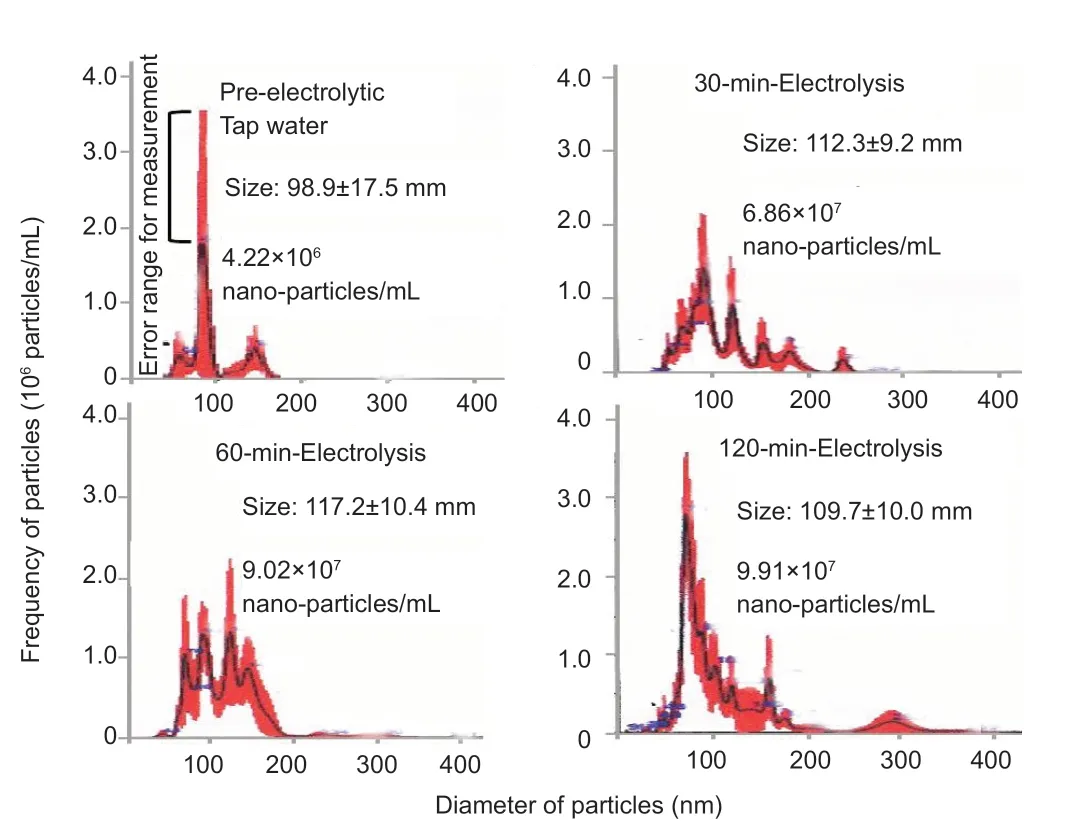
Figure 4:The concentration and size-dependent distribution of nano-bubbles in the electrolyzed water.
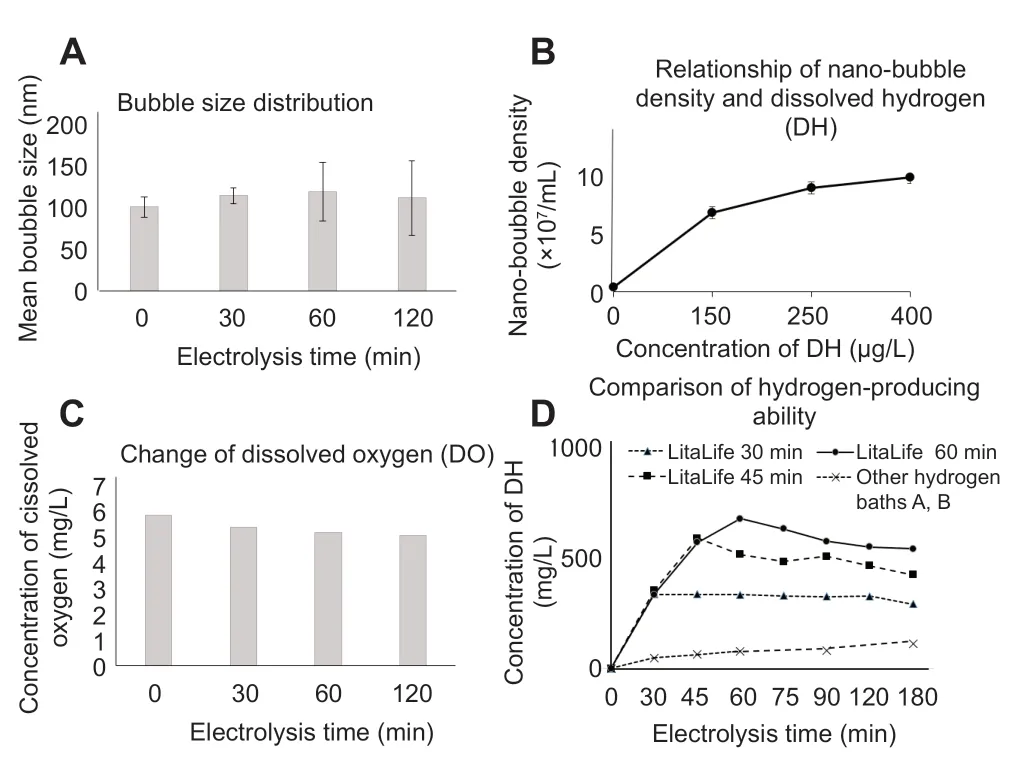
Figure 5:Properties of hydrogen-water generated by an electrolysis apparatus.
Concentrations of hydrogen nano-bubbles were serially measured using the Lita Life instrument.For comparison, other electrolysis instruments (manufactured by A and B companies) were used and evaluated (Figure 5D).The Lita Life exhibited the increase in the hydrogen concentration more rapidly than instruments A and B.For the Lita Life instrument, the electrolysis was intentionally stopped at 30, 45, and 60 minutes after electrolysis was started.After stopping at 30 minutes, the hydrogen concentration (approximately 340 μg/mL) was maintained for 2 hours.After stopping at 45 or 60 minutes, the final hydrogen concentrations increased as the electrolysis duration was prolonged (approximately 590 and 690 μg/mL, respectively), whereas just after stopping the electrolysis, the hydrogen concentrations decreased at 30 minutes and were maintained for almost 2 hours (Figure 5D).Thus, the 60-minute electrolysis and 50- to 80-minute bath was regarded as the best condition conducive to producing and administrating high concentrations of hydrogen nano-bubbles.
In living cells, how hydrogen nano-bubbles exert antioxidant activity is illustrated in the Additional Figure 1.Hydrogen molecules are inherently amphipathic, and moreover the sizes of the bubbles around 100 nm (Figure 5A) were smaller than 1% of the average cell size.And the density of the nano-bubble was found to be as dense as 7–9 × 107/mL in a 30–60-minute electrolysis (Figures 4 and 5B) and one bubble would contain approximately 1.2 × 104/mL H2molecules.Therefore, they were able to pass through the cell membrane easily.The living cells also constantly produced ROS.However, excess amounts of ROS may be produced by some physical hazards such as inflammation, stress, and many pathological events (e.g., tumorigenesis) can be diminished by the hydrogen molecules.28Thus, the symptoms would be reduced by hydrogen nano-bubbles.
short-term HW bath increases antioxidant activity and decreases cRP level in healthy human serum
The short-term effect of hydrogen-rich water bath on peroxyl radical (ROO·) scavenging activity (ORAC capacity) and CRP levels in the human serum was investigated (Figures 6 and 7).In the control group, three subjects exhibited a slight change in their ORAC after taking a normal water bath (Figure 6A).In contrast, the ORAC of the three subjects in the HW group increased rapidly after taking a 10-minute HW bath (Figure 6B) and the increase was significant at 30 and 60 minutes comparing with the value before HW bath (Figure 6C).The results continued to increasein the subject who took the 60-minute HW bath and two subjects who took the HW bath for more than 120 minutes (Figure 6B).Although no significant difference was found between the two groups, it is shown that the ORAC capacity in the HW group markedly increased (Figure 6C), meaning that the hydrogen-rich water bath induces an anti-ROS activity in the human serum.

Figure 6:Effects of hydrogen-rich water (HW) bath on the antioxidant capacity oxygen radical absorption-based antioxidant capacity (ORAC) in the human serum.
The CRP level is inclined to increase as oxidative stress occurs.29CRP is a marker of inflammatory changes inside human body.30The time course of change of the CRP level in the control and HW groups of healthy volunteers is shown in Figure 7A and B, respectively.At 0 to 120 minutes after they took a bath, the CRP level of the HW group was lower than that of the control group (Figure 7C), although no significant difference was found between the two groups, indicating that the hydrogen-rich water bath induces an anti-inflammatory activity in the human tissues.

Figure 7:Effects of short-term hydrogen-rich water (HW) bath on the inflammation indicator C-reactive protein (CRP) levels in the healthy human serum.
Medium-term effect of HW bath on the cRP levels in serum of persons with disease
A high CRP level in the human serum reflects not only the inflammation degrees but also its relation to various diseases, such as obesity and chronic heart failure.31,32Thus, the mediumterm effect of the hydrogen-rich water bath on the CRP level in the human serum in patients with connective tissue disease was examined (Figure 8).Serum samples from three patients with connective tissue disease were obtained before and after the examination period for 9 days to 4 months.Among the three subjects, the CRP rate before and after the bathing examination period decreased to 24%, 34%, and 3%, respectively.
Long-term effect of HW bath on the cRP levels in serum of persons with disease
The long-term effects of hydrogen-rich water bath on the CRP levels in the human serum were examined (Figure 9 and Table 1).All six subjects had CRP values more than the standard value (0.30 mg/dL) before the examination period for hydrogen-rich warm water bathing; however, after the examination their CRP values dropped down to below the standard values.Thus, the beneficial effects of HW bath on CRP repression were recognized among the six patients, although conventional therapeutic treatments other than HW bath could not be avoided or suspended because of diverse refractory diseases seriously affecting the safety of the patients.Thus, the pre-bathing CRP values with an average of 5.31 (0.44–14.4) mg/dL were diminished to an average of 0.24 (0.13–0.45) mg/dL, which is within the standard values (below 0.30 mg/dL), even for an average of 59.5 (42–73)-year-old patients with diverse autoimmune-related diseases.The examining periods have an average of 10 months and 16 days (2–25 months).

Figure 8: Effects of medium-term daily-usage of hydrogen-rich water (HW) bath on CRP levels in serum of human with disease.
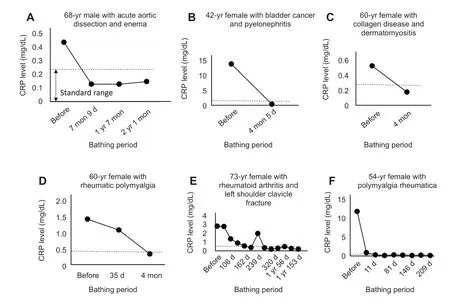
Figure 9: Effects of long-term daily-usage of hydrogen-rich water (HW) bath on the C-reactive protein (CRP) levels in the serum of patients with connective-tissue disease.

Table 1:Long-term effects of hydrogen-rich water (HW) bath on the c-reactive protein (cRP) levels in the human serum
Overall, the hydrogen-rich water bath improved the inflammation marker CRP levels among the six subjects who had CRP values more than the standard value (below 0.30 mg/dL) before the examination period for hydrogen-rich warm water bathing.
Effects of hydrogen-rich water bath on appearances of the skin of persons with disease
The long-term effects of hydrogen-rich water bath on the appearances of the skin of persons with disease were also photographically observed.As shown in Figure 10, after hydrogen bath examination for 4 months, the prominent inflammation regions on the back of both hands of the subject suffering from collagen disease and dermatomyositis (Table 1) were reduced, and internal hemorrhage was improved, without applying any ointment (Figure 10A and B).Figure 10C shows the effects of HW bath on the subject suffering from acute aortic dissection and enema (Table 1).Before HW bathing, he exhibited inflammatory skin symptoms such as swelling and reddish-coloring flushing around the abdomen stoma (shown as “Inflammation” in Figure 10C, upper photograph).However, after taking a hydrogen bath daily, soaking the feet in HW, and applying hydrogen warm water represses on the skin surrounding the stoma for approximately 1 year, 5 months, and 23 days, the inflammatory symptoms were reduced without applying any ointment (Figure 10C, lower photograph).
DIscUssION
Hydrogen-rich water bath is presumed to help hydrogen molecules to permeate into the blood stream through the hair pores, sebaceous glands, and sweat pores in the skin, resulting in the dilatation of the subcutaneous capillaries under the skin, thus increasing subcutaneous blood flow.Moreover, they are easily penetrated into the blood fluid by passing through the blood vessel wall, owing to their nanoscale bubble size, concurrently with systemic circulation and delivery (Figure 11).Therefore, hydrogen-rich water bath is considered to be more capable of promoting the anti-oxidative activity in the blood compared with oral administration and skin ointment for other antioxidants.
By taking a HW bath, hydrogen nano-bubbles could rapidly infiltrate into the dermis and be absorbed into the blood stream, as suggested by the finding that the post-HW-bathing time that is necessary for the elevation of serum antioxidant activity was as short as 30 minutes (Figure 6), as estimated by ORAC assay, which is able to justifiably evaluate timedependent changes for the serum of specified person as the measuring absoluteness rather than comparative evaluation among a diversity of different material sources.A larger size of blood sample drawn repeatedly in time-course is needed to elucidate the process of elevation of serum antioxidant activity.Since hydrogen molecules are electronically neutral and amphipathic, as well as very small in molecular mass, they can easily penetrate the cellular and intracellular membranes of cells and organelles.Therefore, hydrogen molecules can be distributed in the blood and tissues of an organism.13,33For example, it has been reported that after drinking hydrogenrich water, the concentration of hydrogen in exhaled breath from healthy adults reaches a peak at 15 minutes in a dosedependent manner.34
Meanwhile, under inflammation and oxidative stress, the native CRP as the pentamer can be converted into monomeric CRP (Figure 11).35Apart from the turbidimetric immunoassaybased conventional CRP assay of sensitivity as low as below 0.1 mg/mL, recently, the latex agglutination immunoassay/nephelometry-based high-sensitive CRP assay of sensitivity as high as 0.04–0.01 mg/mL is emphatically considered, because of the predictability for prior signs of myocardial infarction and internal organ senescence in addition to acute inflammation.The mCRP then invades into the blood vessel and causes an inflammatory response and oxidative stress that result in immunocytes recruitment, cytokine release, and vascular injury, concurrently with increased generation of ROS.However, once the hydrogen molecules get into the blood stream, they scavenge ROS and protect the cells and tissues from inflammation-/oxidative stress-induced damages.After compulsory administration of hydrogen-rich water to the stomach of a rat via a catheter, the concentration of hydrogen can be increased in the blood within a time as short as 3 minutes.36For comparison, a hydrogen-rich water bath was used to deliver hydrogen molecules to subjects in the present study.The ORAC-based antioxidant capacity of the serum can be increased 10 minutes after taking the hydrogen bath.This increase continued for more than 1 hour.Additionally, the CRP levels in the serum began to be reduced 2 hours after HW bathing.The data suggest that hydrogen molecules can rapidly pass through the skin and be absorbed into the blood stream as well as increase TAC and consequently decrease the inflammatory factors in healthy subjects (Figures 6 and 7).As compared to other diverse antioxidants, the reducing effects of hydrogen by itself may be much weaker.37However, because certain levels of ROS are crucial as triggering or relaying signals for many biological processes,24,38strong antioxidants could occasionally have harmful effects by blocking ROS.As mentioned in a systematic review, synthetic antioxidants may increase mortality.4Comparatively, in the present study, our data showed that hydrogen-rich water has both short-, medium- and long-term effects on the increasing TAC and reducing CRP.This probably is beneficial for long-term health maintenance, therefore assumedly reducing mortality.

Figure 10:Effects of long-term daily-usage of hydrogen-rich water (HW) bath on the appearance of the skin of higher-CPR patients.
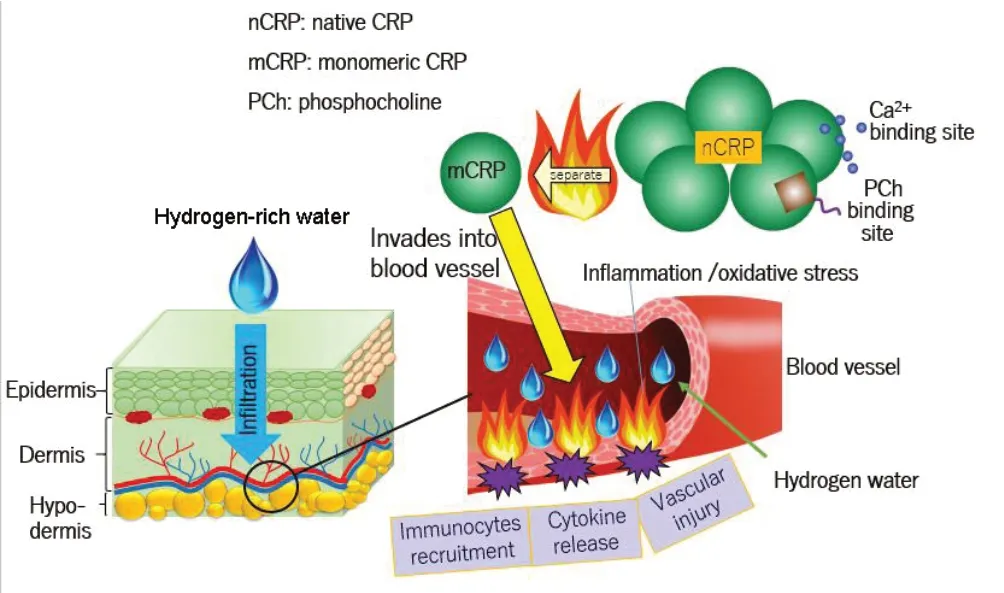
Figure 11:Schematic illustration of oxygen radical absorption-based antioxidant capacity increase-based antioxidant activity and C-reactive protein (CRP) decrease-based anti-inflammatory activity which were concurrently executed by hydrogen-rich water bath.
It is difficult to secure medium- to long-term cooperation among subjects with diseases; thus, the limitation of this study is to end in a case study.
This study also revealed that the hydrogen-rich water bath improved the appearance of skin among persons with diverse ROS-related diseases.The ROS-scavenging ability of the abundant DH in hydrogen-rich water bath helps in the lightening and size reduction of the dark dermal spots and stains, improving skin quality.18It was presumed that the skin epidermal layers containing melanin and lipofuscin, which cause spots, were expelled out of the skin surface such as dirt through hydrogen-activated keratinocyte proliferation and/or were reductively bleached by the whitening power of hydrogen.18Moreover, similar effects of the hydrogen-rich water bath could be considered for other tissues and blood/capillaries.
Acknowledgements
The authors would express their gratitude to Dr.Yuki Takada of Incorporated Association Institute for Hydrogen Medicine for his technical assistance.
Author contributions
YT:manuscript writing, data analysis and reference-literature search; LX:experimental data obtaining, manuscript preparation and fund acquisition; NM:preparation of human serum samples, physicochemical analysis, and cooperation among the authors.All authors approved the final version.
conflicts of interest
None declared.
Open access statement
This is an open access journal, and articles are distributed under the terms of the Creative Commons AttributionNonCommercial-ShareAlike 4.0 License, which allows others to remix, tweak, and build upon the work non-commercially, as long as appropriate credit is given and the new creations are licensed under the identical terms.©Article authors (unless otherwise stated in the text of the article) 2022.All rights reserved.No commercial use is permitted unless otherwise expressly granted.
Additional files
Additional Figure 1:The mechanism of hydrogen bubbles to exert antioxidant activity in the living cells.
Additional file 1:Hospital ethics approval (Japanese).
Additional file 2:Informed consent form (template) (Japanese).
- Medical Gas Research的其它文章
- Current research progress of isoflurane in cerebral ischemia/reperfusion injury:a narrative review
- Comparative analgesic, hemodynamic, pain and duration of sensory and motor block effects of dexmedetomidine, granisetron, and nitroglycerin added to ropivacaine in intravenous anesthesia for forearm surgeries:a randomized clinical study
- Effects of different fresh gas flows and different anesthetics on airway temperature and humidity in surgical patients:a prospective observational study
- Color change after tooth bleaching with ozone and 10% ozonized carbamide peroxide for in-office use
- In vivo microelectrode monitoring of real-time hydrogen concentration in different tissues of rats after inhaling hydrogen gas
- spuriously low end tidal carbon dioxide in capnometry:Nafion tube malfunction in end tidal carbon dioxide module blamed for near mishap!

